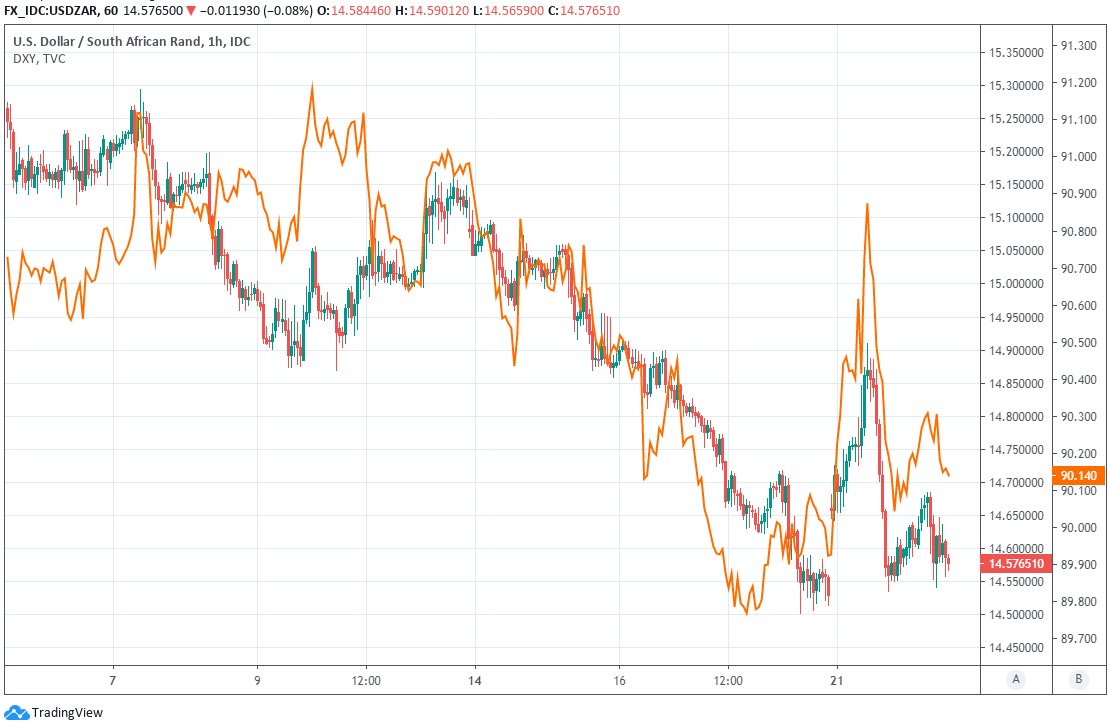South African Rand Bats Away Tiers and Coronavirus Fears but Dollar Demand Contains Recovery
- Written by: James Skinner
-
- ZAR recovers losses but remains roadblocked by 15.0.
- Thin trade & USD demand to curb USD/ZAR downside.
- GBP/ZAR skates on thin ice as Brexit clock ticks away. 
© Lefteris Papaulakis, Adobe Images
- GBP/ZAR spot rate at time of writing: 19.55
- Bank transfer rate (indicative guide): 18.87-19.01
- FX specialist providers (indicative guide): 19.26-19.42
- More information on FX specialist rates here
The Rand had recovered earlier losses against the Dollar on Tuesday after batting away concerns about the impact of a new strain of coronavirus that's spreading in the country, although lingering demand for the safe-haven U.S. unit could keep the South African from further gains throughout the holiday weekend.
Further upside for the Rand may be limited in light of tepid but widespread demand for the Dollar, which comes amid reduced trading volumes in illiquid holiday markets, although the South African currency had on Tuesday recovered all of Monday's sudden, sharp declines.
"The swell in bullish momentum has disappeared even as US Congress signs off on a second virus relief package. The change of mood music should be put into perspective though. In the case of the US, a 0.7% decline in the S&P after a 14.5% surge since early November is neither here nor there. According to virologists, we should not panic about the new COVID variant," says Carole Laulhere, an FX and rates strategist at Societe Generale. "The price action in USD/ZAR sums up the appetite to buy dips in EM."
South Africa, much like the island of Great Britain, was increasingly isolated at the beginning of the festive holidays after a new and more virulent form of coronavirus was detected in the country leading others to restrict flights as well as movements into and out of the country.
At first glance, and quite apparently, that isolation delivered a setback to the Rand as it curbed investors' appetite for risky assets while appearing to further call into question a domestic economic recovery that had already been hampered this December when parts of the country were placed under tighter coronavirus-related restrictions.
Above: USD/ZAR shown at hourly intervals alongside U.S. Dollar Index (orange line).
But border closures do little additional damage to a tourism sector that had already been decimated by the earlier national 'lockdown' in South Africa and renewed nationwide shutdowns in Europe and other major sources of tourist flows, according to some South African media outlets.
"The USD is higher across the board once again even though risk appetite has stabilised today. Cable and the antipodeans are leading the G10 complex lower, although GBP's moves have been more muted than yesterday's," says Ned Rumpeltin, European head of FX strategy at TD Securities.
The Rand was quick to recover from Monday's losses, which some analysts have attributed to ongoing robust investor demand for the comparatively more attractive bond yields on offer in the emerging markets - a trend that's widely expected to support developing world currencies in 2021.
{wbamp-hide start} {wbamp-hide end}{wbamp-show start}{wbamp-show end}
However, over the coming days trading activity will inevitably be reduced as market participants adjourn many countries for the Christmas break, which could keep the Dollar afloat and see the Rand contained beneath earlier highs against its U.S. counterpart until the New Year.
"The key driver remains the closing of trade/borders with the UK due to the variant Covid outbreak and the risk of broader and tighter international restrictions should, or when, the variant become widespread in other countries," says Tim Riddell, a London-based macro strategist at Westpac.
South Africa's Rand was resilient enough to keep USD/ZAR from rising above 15.0 during Monday's sell-off, but has not yet been able to garner the momentum necessary to push the Dollar below 14.50, which coincides with a major technical support level.
Above: USD/ZAR shown at weekly intervals alongside U.S. Dollar Index (orange line).
The 61.8% Fibonacci retracement of the 2018 USD/ZAR uptrend called last week's Rand rally to a halt and may prove to be a bridge too far for the Rand to overcome in the holiday period. The Pound-to-Rand rate on the other hand, is a different story with Britain, the island as well as economy, isolated and potentially barely more than a week away from a 'no deal' Brexit cliff edge.
"While GBP is likely to find support on any news that a trade deal has been struck, it remains likely that any relief rally will be cut short. Firstly, any deal is set to leave many sectors, particular in services, out in the cold. In addition, the likelihood that larger swathes of the UK will be entering higher ‘tier 4’ restrictions to prevent the transmission of the virus will significantly dampen recovery prospects," says Jane Foley, a senior FX strategist at Rabobank.
Differences over the extent of Europe's access to British waters and fisheries following the UK's departure from the transition on December 31 remained the most widely cited impediment to an agreement, although with a bill normally requiring a minimum of four days to be rushed onto the statute book, time was running short on Tuesday.
{wbamp-hide start}{wbamp-hide end}{wbamp-show start}{wbamp-show end}
The danger for Sterling now is that it weakens as the clock ticks down and the prospect of a relationship governed by World Trade Organization terms and tariffs draws closer. The Pound-Rand rate could fall as far as 18.14 in a 'no deal' Brexit scenario, according to some analyst estimates, which would erase the remainder of Sterling's 2020 gains.
"Barring some type of dramatic shift over the next 24 hours (or less), it's now difficult to see how even a 'skinny' UK/EU-27 arrangement can be ratified by both sides in time for midnight on December 31," says Stephen Gallo, European head of FX strategy at BMO Capital Markets. "FX investors can probably foresee a situation in which no formal deal is reached by December 31 and a temporary arrangement is agreed that maintains 100% tariff-free trade. But there are two key risks to this scenario: the first is the government's preoccupation with managing COVID-19 and its economic impact (the appetite for an extension on the UK side appears very low). The second risk is that a temporary arrangement may require one or two big concessions from either side to occur first, so that talks can continue after December 31. Such concessions are certainly possible, but at the moment they don't appear particularly likely."
Above: Pound-to-Rand rate shown at weekly intervals.

